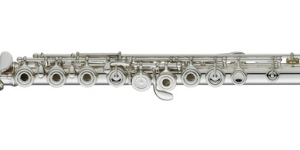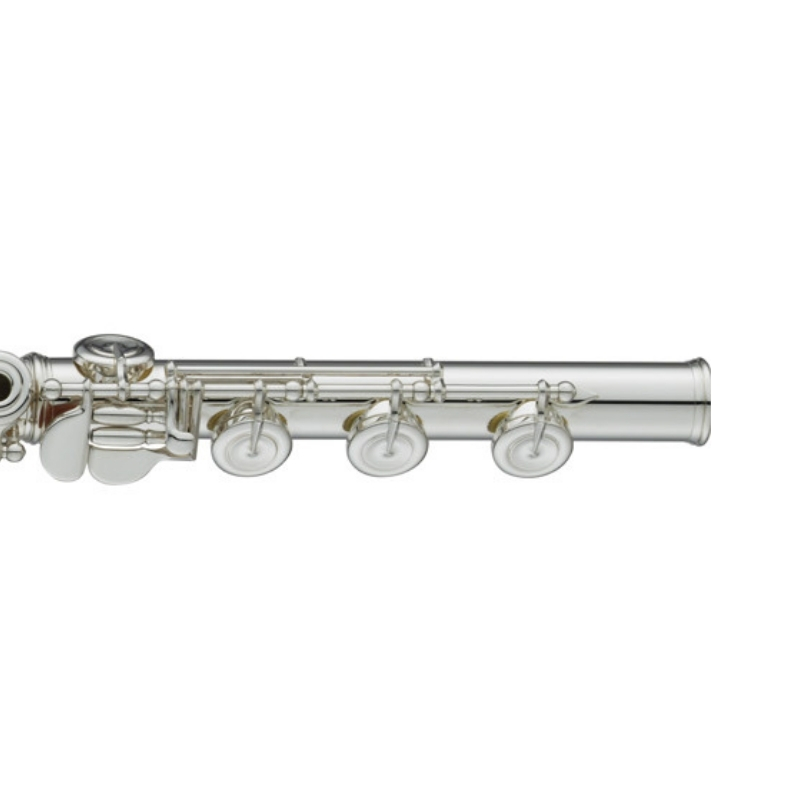
Purchasing an Advanced Model Flute

What flute should I buy? How do I choose options? What do all these terms mean?
Buying an intermediate or professional flute is the perfect opportunity to take your skills and abilities to the next level. But, it can be daunting! There are many options, and choosing the right options for you or your student can be difficult to navigate.
This flute buying guide and the helpful staff at DFMC are here to help!
We've answered some of the most common questions about Advanced Model flutes:
Are Flutes Made of Silver?
Many student and intermediate flutes are made from Nickel Silver or Sterling Silver, while professional flutes are a combination of Sterling and Solid Silver or even Gold. Why? It's all about sound quality. Higher quality materials such as silver or gold provide higher quality sound. However, they are soft and require careful maintenance. Nickel silver is stronger and is better for beginners.
Many advanced model flutes will list the metals that the body, keys and headjoint are made out of separately so it is
easy to figure out what exactly the flute is made of. The metals used make up the majority of the differences in price. You may see "Silver Plated" listed on many intermediate models - Plating refers to a process where a thin layer of silver is put over the top of another material. Solid Silver means that the entire piece is made of silver. Solid Silver headjoints are very popular. Since the headjoint has the most direct contact with the player’s air supply and embouchure (mouth position), its material greatly affects the flute’s sound.
Open Holes

Open holes, often called French or Ring Keys, are a feature on virtually all advanced level Flutes. Open Holes allow the player greater control over the sound they are creating, and give a much desired nuance to playing the instrument. They can also assist in advanced playing techniques, such as the glissando. This feature is highly recommended if you are buying an advanced model flute.
It is an adjustment for flutists who play on closed-hole flutes, especially if they are young musicians, to get used to flutes with open holes. Small fingers sometimes don't cover the holes completely, and can lead to struggles with a newly purchased instrument. Key plugs should be purchased or may be included with your Flute to help transition from closed to open hole. Plugs can be taken out one by one as you adjust to the new instrument.

Feature: B Foot
What is a B foot? You may have noticed that most intermediate and professional flutes have three keys on the foot joint instead of two. A flute with three keys on the foot has a B Foot.
The B foot allows a flutist to play down to a low B and thus is a desirable trait in an advanced model flute. This expanded range is important for an advancing musician.
Feature: Split-E Mechanism
The Split E mechanism facilitates the playing of an E in the third octave, and again is a desirable trait in an advanced model flute. Not all intermediate and professional flutes come standard with this feature, but it is a feature that is worth it.
The offset G key feature is sometimes the most confusion choice for families looking to purchase something for their child, because it is all about personal preference. "The G keys of a flute can be made inline or offset. There is no difference in the tone produced with inline or offset G keys, it is simply a matter of comfort and preference. Inline G keys are in a straight line with the rest of the keys on the flute and are all mounted on the same rod. Offset G keys are offset slightly from the rest of the keys and are mounted on separate posts. A growing number of flutists prefer the comfort and hand position on the offset G flute." - Azumi.com
Professionals and students alike often find that the Offset G is easier to reach and maintain a comfortable hand position. In recent years, Offset G has become the standard choice for many musicians and private lesson teachers so you may see more flutes with the Offset G than the Inline G available in stores and online.
Feature: C# Trill Key
The C# trill key is preferred by many Professional flutists. It simplifies many awkward trill and tremolo fingerings, but isn't available on all models of instrument. Many young players have no need for this additional key, but it can be useful if you are looking to buy a lifelong instrument that will grow with you or your young musician.
As with all professional instrument purchases, it is important to try out many different flutes in order to find the one that is right for you. The features of intermediate and professional flutes are important to the sound of the instrument, but what’s most important is an instrument that allows you to play your best.
Try out different pieces and styles of playing on the flutes you are considering and try comparing two at a time and eliminating those that don’t work for you.
Enjoyed this post? You may also like …
What Instrument Should I Play?
What instrument should I play? When starting band or orchestra, students are faced with so many options. The list of instruments to choose from can be overwhelming. This post is here to help!
How to Find the Right Step-up Instrument
Which step-up instrument should I choose? How much will it cost? This post will help you choose the best step-up instrument for you!

